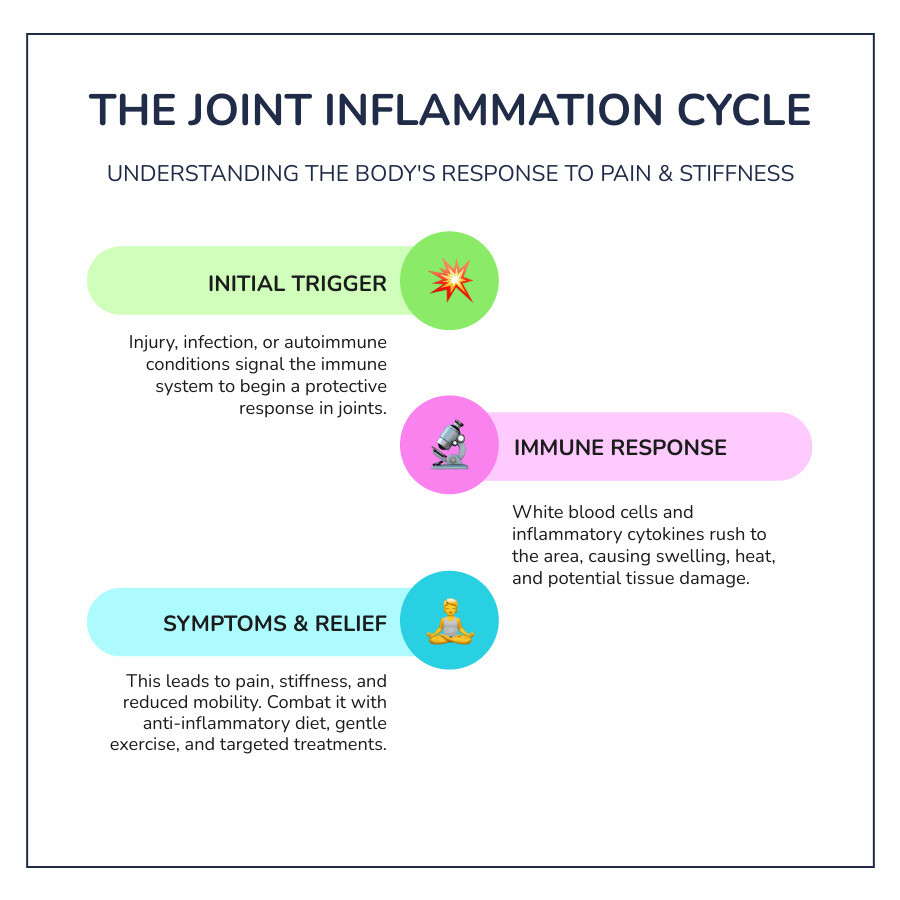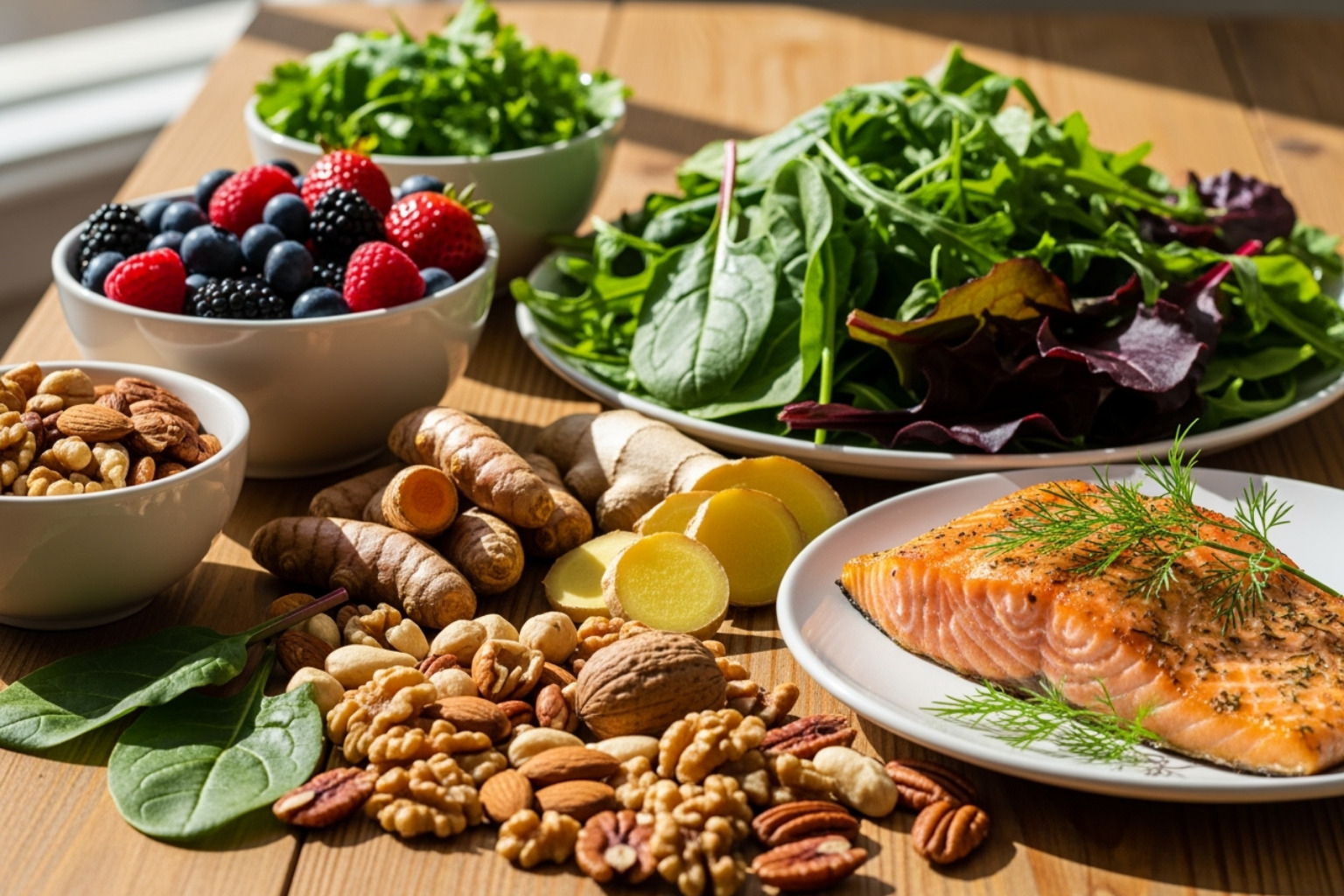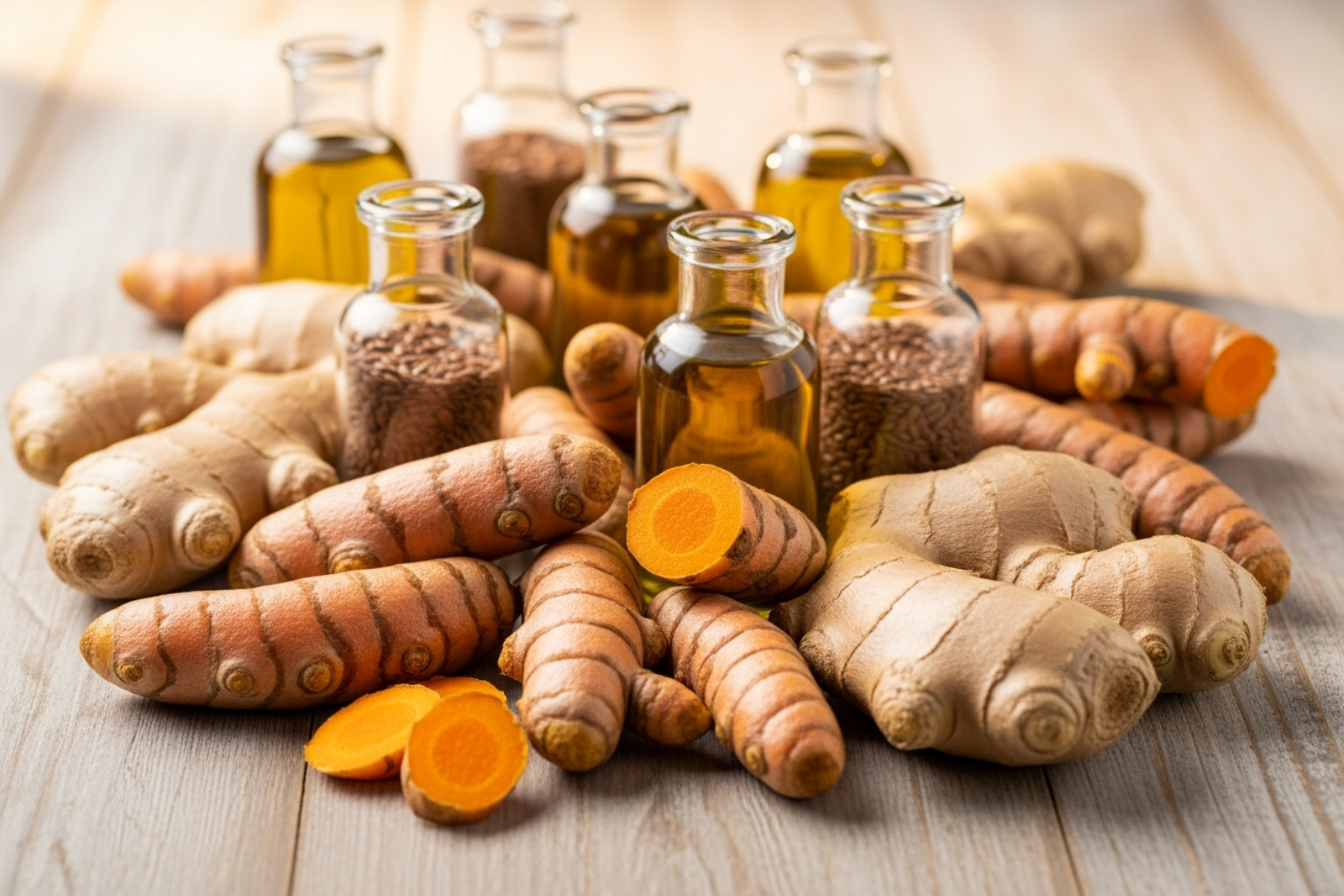Why Joint Pain Affects Millions and How You Can Find Relief
What helps joint inflammation? If you have aching, stiff joints, you're not alone. Relief lies in a combination of proven approaches that target inflammation at its source.
Quick Relief Strategies for Joint Inflammation:
- Anti-inflammatory foods - salmon, berries, leafy greens, turmeric
- Natural supplements - omega-3 fatty acids, vitamin D, curcumin
- Gentle movement - low-impact exercise, stretching, swimming
- Weight management - reducing strain on joints
- Topical treatments - natural pain relief creams for targeted comfort
- Lifestyle changes - stress reduction, quality sleep, avoiding inflammatory foods
Joint pain impacts 54 million Americans with arthritis, and one in four experiences severe joint pain limiting daily activities, according to the CDC. Understanding inflammation is the first step toward relief.
Simple changes to your diet, exercise, and daily habits can dramatically reduce joint inflammation. Studies show an anti-inflammatory diet may cut gout risk by over 30%, while losing one pound reduces knee joint load by four pounds, according to the Cleveland Clinic.
Joints become inflamed when your immune system sends white blood cells to fight injury or infection. When this process goes wrong, it creates chronic inflammation that damages healthy tissue, leading to swelling, stiffness, and pain.
I'm Tony Enrico, and through my work with Neuropasil, I've helped thousands find effective, natural relief from joint discomfort. My experience shows that understanding what helps joint inflammation is key to getting back to the activities you love.

Important What helps joint inflammation? terms:
Understanding Joint Inflammation: The Root of Your Pain
Inflammation is your body's security system. When you're injured, your immune system sends white blood cells to heal the area, causing redness and swelling. This is acute inflammation.
But sometimes this system gets stuck on. Chronic inflammation is when this response continues without a real threat, damaging the very tissues it's meant to protect. In your joints, this creates the swelling, stiffness, and pain that can make simple tasks overwhelming. The CDC reports that 54 million Americans have arthritis, with one in four experiencing severe, limiting joint pain.
What are the primary causes of chronic joint inflammation?
Understanding the triggers is key to finding out what helps joint inflammation for you.
- Chronic conditions: Osteoarthritis, once seen as simple "wear and tear," involves inflammation that accelerates cartilage breakdown. Rheumatoid arthritis is an autoimmune condition where the immune system attacks healthy joint tissues. Gout occurs when uric acid crystals build up in joints, triggering intense inflammatory episodes.
- Obesity: Extra weight adds mechanical stress, and fat tissue produces inflammatory chemicals called cytokines that fuel joint inflammation.
- Damaged tissue: After an injury or surgery, the inflammatory response can sometimes fail to turn off, leading to ongoing discomfort.
- Inflammatory messengers: Overproduction of chemicals like IL-6 and TNF-alpha creates a self-perpetuating cycle of inflammation and pain.
How does inflammation lead to joint pain?
Chronic inflammation sets off a destructive chain reaction in your joints.
- Cartilage degradation: Inflammatory chemicals break down the smooth cartilage that allows bones to glide effortlessly, reducing shock absorption.
- Nerve irritation: The inflammatory process irritates nerve endings around the joint, sending constant pain signals to your brain.
- Swelling pressure: Fluid and immune cells build up in the joint capsule, causing tightness, stiffness, and reduced range of motion.
- Bone-on-bone friction: As cartilage wears away, bones can grind against each other, causing sharp, intense pain.
- Loss of joint function: Over time, these structural changes can make normal movement difficult or impossible.
Understanding these mechanisms helps identify what helps joint inflammation and empowers you to interrupt this destructive cycle.
The Anti-Inflammatory Diet: Eating Your Way to Relief

Your kitchen can be a powerful tool against joint pain. Choosing whole foods over processed junk can help you feel better and move with less pain by using the power of antioxidants and polyphenols.
As Harvard Health confirms, an anti-inflammatory diet is good for your joints. The benefit comes from changing your overall eating pattern, not from a single "superfood."
Foods to Accept for Joint Health
Focus on these flavorful, anti-inflammatory foods:
- Fatty fish: Salmon, mackerel, and sardines are packed with omega-3 fatty acids (EPA and DHA), which act as natural anti-inflammatories. Aim for two servings a week.
- Nuts and seeds: Walnuts, almonds, and flaxseeds provide healthy fats and fiber. A small handful daily can make a difference.
- Vibrant fruits: Berries and cherries are loaded with antioxidants and anthocyanins that fight inflammation.
- Leafy greens and colorful vegetables: Spinach, kale, and broccoli deliver antioxidants and vitamin K, which can reduce inflammatory markers.
- Whole grains: Oatmeal, brown rice, and quinoa help lower C-reactive protein (CRP), a key inflammation marker.
- Extra virgin olive oil: Contains oleocanthal, a compound with ibuprofen-like anti-inflammatory effects.
- Beans: Red beans, kidney beans, and pinto beans are rich in fiber and phytonutrients that help lower inflammation.
Foods to Limit or Avoid
Knowing what helps joint inflammation also means knowing what makes it worse. Limit or avoid these inflammatory triggers:
- Added sugars: Found in sodas, desserts, and many processed foods, sugar causes your body to release inflammatory messengers called cytokines, as shown by the American Journal of Clinical Nutrition.
- Saturated and trans fats: Found in red meat, pizza, and fried foods, these fats trigger and promote inflammation.
- Refined carbohydrates: White bread and sugary treats break down into sugar quickly, causing an inflammatory response.
- Processed meats: Hot dogs and bacon are often high in saturated fat and sodium, which fuel inflammation.
- Excess omega-6 fatty acids: Common in vegetable oils, they can promote inflammation if not balanced with omega-3s.
The Power of Anti-Inflammatory Diets
Adopting an overall anti-inflammatory eating pattern is more effective than focusing on single foods. Two proven approaches are:
- The Mediterranean Diet: Emphasizes fruits, vegetables, whole grains, olive oil, and fish. The Arthritis Foundation notes this pattern is rich in foods that fight inflammation.
- The DASH Diet: (Dietary Approaches to Stop Hypertension) follows similar principles, focusing on whole foods while limiting saturated fat and sodium.
An anti-inflammatory diet may cut your gout risk by over 30%. Sustainable, delicious choices nourish your body and soothe your joints over time.
Powerful Nutrients and Natural Approaches: What Helps Joint Inflammation?

Specific nutrients and natural compounds offer powerful support against joint inflammation. These bioactive compounds work to calm the inflammatory storm at its source. Always consult your healthcare provider before starting a new supplement routine, especially if you take other medications.
Key Nutrients That Fight Inflammation
Certain nutrients are champions when it comes to what helps joint inflammation:
- Omega-3 fatty acids (EPA & DHA): Found in fish and algae, these fats are potent anti-inflammatory agents. Research in the Mediterranean Journal of Rheumatology shows that increased omega-3 intake can reduce morning stiffness and joint tenderness in people with rheumatoid arthritis. Getting these fats from fish or supplements is most effective.
- Vitamin D: Adequate levels of the "sunshine vitamin" may reduce your risk of developing inflammatory arthritis.
- Vitamin B6: A study in PMC found that Vitamin B6 helps protect joints by reducing inflammatory cytokines and helping build cartilage components.
What helps joint inflammation in the form of herbal and natural remedies?
Nature provides several botanical remedies for joint discomfort:
- Turmeric: Contains curcumin, a compound that some studies suggest is as effective as ibuprofen for knee osteoarthritis pain.
- Ginger: This root contains compounds with anti-inflammatory effects that rival ibuprofen.
- Nettle: Traditionally used to reduce inflammation, research shows it can work by lowering levels of inflammatory cytokines.
- Bromelain: An enzyme from pineapple with anti-inflammatory and pain-relieving properties. Research in PMC shows it works well in combination with other compounds like curcumin.
Are there other effective approaches for joint comfort?
Yes, other approaches can provide immediate, targeted comfort:
- Gentle stretching: Daily stretching maintains range of motion and prevents stiffness.
- Warm compresses: Heat therapy increases blood flow and relaxes tense muscles, offering soothing relief for aching joints.
- Topical relief creams: These deliver active ingredients directly to the source of discomfort for targeted relief. As studies in PMC show, topical treatments can be highly effective.
At Neuropasil, our creams are formulated for this purpose. Natural ingredients like menthol, urea, and aloe penetrate deeply to calm localized inflammation and provide fast-acting comfort, helping many customers return to the activities they love.
Lifestyle Changes for Lasting Joint Comfort
Diet and nutrients work best as part of a bigger picture. Sustainable joint health comes from creating daily habits that support your body's natural healing processes. Small lifestyle changes can create ripple effects that transform how you feel.
The Role of Weight Management
Carrying extra weight affects joints in two ways: it adds mechanical stress, and fat cells produce inflammatory chemicals. You don't need dramatic weight loss for real benefits. The Cleveland Clinic notes that losing just one pound reduces the load on your knee joints by four pounds. A major study of overweight adults found that those who lost 10% or more of their body weight had dramatically lower inflammation markers and less pain.
The Impact of Physical Activity
When your joints hurt, you may fear exercise, but the right kind of movement is medicine for inflamed joints. Regular, gentle exercise reduces pain and stiffness by strengthening the muscles that support your joints. Consider these low-impact options:
- Swimming and Cycling: The water's buoyancy supports your body, while cycling offers smooth, controlled movement without jarring impact.
- Walking: One of the best low-impact exercises. Start slowly and build up gradually.
- Gentle yoga and tai chi: These combine movement with mindfulness, improving flexibility and reducing stress.
Strong muscles act as shock absorbers, and flexibility from stretching prevents stiffness. Listen to your body and consider a physical therapist to create a safe, custom exercise plan.
What helps joint inflammation beyond diet and exercise?
Other lifestyle factors play a crucial role in managing inflammation:
- Stress management: Chronic stress triggers inflammatory responses. Mind-body therapies like yoga, meditation, and even deep breathing can calm your nervous system and reduce inflammation.
- Quality sleep: During deep sleep, your body repairs tissue and reduces inflammation. Aim for 7-9 hours of restful sleep per night. As research confirms, poor sleep disrupts this process, leading to more pain.
- Quitting smoking: The toxins in cigarette smoke damage connective tissues and worsen arthritis, as confirmed by Johns Hopkins Medicine. Quitting can significantly improve joint pain within months.
Frequently Asked Questions about Joint Inflammation
Here are answers to common questions about what helps joint inflammation.
How long does it take for an anti-inflammatory diet to work?
There's no single timeline, as everyone's body responds differently based on inflammation severity and consistency. Most people notice subtle improvements within a few weeks, like less morning stiffness. For more significant relief, plan on several months of consistent effort. Chronic inflammation takes time to develop and reverse. Consistency is key.
Can joint inflammation be completely cured?
This depends on the cause. Acute inflammation from an injury will resolve as you heal. Chronic conditions like rheumatoid or severe osteoarthritis require ongoing management rather than a cure. However, effective management through diet, exercise, and lifestyle changes can dramatically improve quality of life, sometimes leading to remission. The goal is to empower yourself to manage the condition, not seek a magic cure.
Is heat or cold better for joint inflammation?
As the Mayo Clinic explains, both are useful, but for different purposes:
- Cold therapy is best for acute situations like a recent injury or a flare-up with visible swelling and heat. Cold constricts blood vessels, which reduces swelling and numbs pain. Apply an ice pack wrapped in a towel for 15-20 minutes.
- Heat therapy is ideal for chronic stiffness and muscle tension. Warmth increases blood flow, relaxes muscles, and improves flexibility. Use a heating pad or warm bath for about 20 minutes.
Many people find alternating between cold and heat provides the best results. Trust what feels best for your body.
Conclusion
Taking charge of your joint health is achievable. We've seen that what helps joint inflammation is a combination of daily choices that calm your body's inflammatory response.
- Diet: Fill your kitchen with anti-inflammatory foods like salmon, berries, and leafy greens while cutting back on sugars and processed foods.
- Weight Management: Losing just one pound takes four pounds of pressure off your knees.
- Movement: Gentle, consistent exercise like swimming or walking strengthens muscles and keeps joints mobile.
- Lifestyle: Prioritize quality sleep, manage stress, and consider quitting smoking to support your joints.
- Natural Support: Supplements like omega-3s and turmeric offer additional support, while topical treatments provide targeted relief.
You have more control over your joint comfort than you might realize. Small, consistent changes in how you eat, move, and live lead to significant improvements. It's about progress, not perfection.
For targeted, soothing relief from joint discomfort, consider Neuropasil. Our fast-acting topical relief cream combines the natural power of Aloe, Urea, and Menthol to provide powerful, targeted comfort for aches, strains, and joint discomfort. It helps many of our customers manage daily discomfort and get back to the activities they love.
Find fast-acting topical relief for your sore joints
Your journey to better joint health starts now. Every positive step counts.
References
- Anti-Inflammatory Diet for Joints: Harvard Health
- Arthritis National Statistics: Centers for Disease Control and Prevention (CDC)
- Gout Risk and Diet: BMJ
- Heat vs. Cold Therapy for Joint Pain: Mayo Clinic
- Herbal Anti-Inflammatory Combinations: PMC
- Mediterranean Diet for Arthritis: Arthritis Foundation
- Nettle and Inflammatory Cytokines: Phytomedicine
- Obesity and Inflammation: Nature Reviews Endocrinology
- Olive Oil and Oleocanthal: Nature
- Omega-3s for Rheumatoid Arthritis: Mediterranean Journal of Rheumatology
- Sleep and Inflammation: Best Practice & Research Clinical Endocrinology & Metabolism
- Smoking and Arthritis: Johns Hopkins Medicine
- Stress and Inflammation: Frontiers in Human Neuroscience
- Sugar and Inflammation: American Journal of Clinical Nutrition
- Topical Treatments for Joint Comfort: PMC
- Turmeric for Osteoarthritis Pain: The Journal of Alternative and Complementary Medicine
- Vitamin B6 and Osteoarthritis: PMC
- Vitamin D and Arthritis Risk: The Journal of Steroid Biochemistry and Molecular Biology
- Weight Loss and Joint Pain: Cleveland Clinic
- Weight Loss, Exercise, and Knee Pain (IDEA Trial): National Institutes of Health (NIH)
- Whole Grains and CRP: American Journal of Clinical Nutrition














